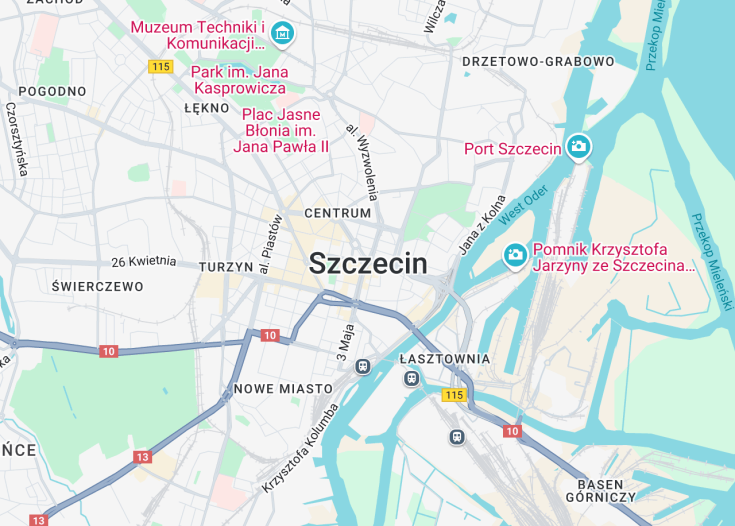Szczecin, a captivating city situated on the Oder River in northwest Poland, is an exquisite blend of cultural heritage and modern aesthetics. Known for its historical architecture, Szczecin features landmarks such as the Pomeranian Dukes’ Castle and the Gothic St. James Cathedral.
The city also offers vibrant parks and a revitalized waterfront that invites leisure and exploration. With a rich maritime history and a dynamic arts scene, Szczecin provides a unique cultural experience that stands out among European destinations.
Before traveling to Szczecin, explore the options for river cruises on the Oder River, which provide stunning views of the cityscape and a refreshing perspective on its historical sites.
Visit in early September to experience the annual Szczecin Music Fest. This event showcases a mix of classical, jazz, and contemporary music, reflecting the city’s rich cultural tapestry.
Szczecin: A Gateway to the Baltic
| Country | Poland |
| Time in Szczecin | GMT+1 |
| Language spoken | Polish |
| Population | 400,000 (source: Statistical Office in Szczecin, 2023) |
| Currency | Polish Złoty (PLN, zł) |
| Airports |
|
Szczecin, a city steeped in history and culture, sits along the Oder River near the Baltic Sea in northwest Poland. As Poland’s seventh-largest city, Szczecin has played a crucial role historically as a port and shipbuilding center. Its complex past, influenced by both Polish and German heritage, is evident in its diverse architecture, from Gothic cathedrals to modernist buildings.
Where is Szczecin?
Szczecin is located in the northwest of Poland, near the border with Germany.
Distances:
| Route | Distance by car | Time by car |
|---|---|---|
| Warsaw to Szczecin | 325 miles | 5h 30m |
| Krakow to Szczecin | 430 miles | 7h 15m |
| Gdansk to Szczecin | 230 miles | 4h |
What is Szczecin famous for?
Szczecin is renowned for its majestic Oder River views, historical fortifications, and the Pomeranian Dukes’ Castle, blending rich history with a vibrant cultural scene.
History
Early Settlements and Medieval Foundations (before 1243)
The region around present-day Szczecin has been inhabited since the Stone Age, evolving through various cultural phases including the Bronze and Iron Ages. The area saw significant developments during the early Slavic settlements. Szczecin itself, originally a West Slavic Pomeranian stronghold, was pivotal due to its strategic location along the Oder River, which made it a crucial point for trade routes connecting the Baltic Sea with Central Europe.
Duchy of Pomerania and Hanseatic League (1243-1637)
In 1243, Szczecin became officially recognized as a city and swiftly grew into an influential commercial center with the arrival of German traders and settlers. The city joined the Hanseatic League in the 14th century, entering its golden age of prosperity and influence in the Baltic trade network. This period was marked by architectural developments and the construction of significant edifices like the Pomeranian Dukes’ Castle.
Swedish and Subsequent Control (1637-1945)
Post the Thirty Years’ War, Szczecin came under Swedish control before passing into Prussian, and later German, hands after the Treaty of Stockholm in 1720. The city evolved into a major industrial and maritime hub of the German Empire. Despite severe damage during the Second World War, especially towards its end, Szczecin’s infrastructure and population were significantly impacted, leading to major urban and demographic changes post-war.
Modern Era and Rebuilding (1945-Present)
Following the Potsdam Agreement in 1945, Szczecin was assigned to Poland, leading to extensive resettlement and reconstruction. The city was rebuilt in a socialist-realism style during the communist era, and since the fall of communism in 1989, it has been undergoing a process of economic and cultural revitalization, transforming into a vibrant modern city with extensive historical heritage.
Visit Szczecin
Attractions and Activities in Szczecin
Visitors to Szczecin are greeted with a mix of historical sites and vibrant modern attractions. Key landmarks include the Pomeranian Dukes’ Castle, with its museums and cultural events. The Gothic St. James’s Cathedral offers panoramic city views from its tower.
For nature lovers, the Central Cemetery, one of the largest of its kind in Europe, provides a serene park-like atmosphere. The city’s waterfront, along the Oder River, is perfect for leisurely walks or bike rides. Cultural experiences are plentiful, especially at the National Museum, which houses an extensive collection of artifacts that narrate the region’s rich history.
- Pomeranian Dukes’ Castle
- St. James’s Cathedral
- Szczecin Central Cemetery
- Oder River waterfront
- National Museum
Annual Events in Szczecin
Szczecin hosts several cultural and musical events throughout the year that attract visitors globally. The Szczecin Jazz Festival, held every February, is a major highlight, featuring international artists and vibrant performances.
In the summer, the Szczecin Art Festival brings together various art forms, from visual arts to theatrical performances, creating a dynamic cultural scene in the city.
Best time to visit Szczecin
The best times to visit Szczecin are late spring (May-June) and early autumn (September-October). During these months, the weather is most favorable, and the city’s parks and gardens are in full bloom, while the cultural calendar is bustling with events and festivals, making it an ideal time for tourists to experience both the natural and cultural richness of Szczecin.
Is Szczecin worth visiting?
Szczecin is indeed worth visiting for its rich tapestry of history, cultural depth, and scenic beauty. The city offers a unique blend of historical architecture and modern developments, alongside green havens and vibrant cultural life.
Whether you are a history enthusiast, nature lover, or culture seeker, Szczecin provides a compelling array of attractions and experiences that cater to diverse interests, making it a rewarding destination.









